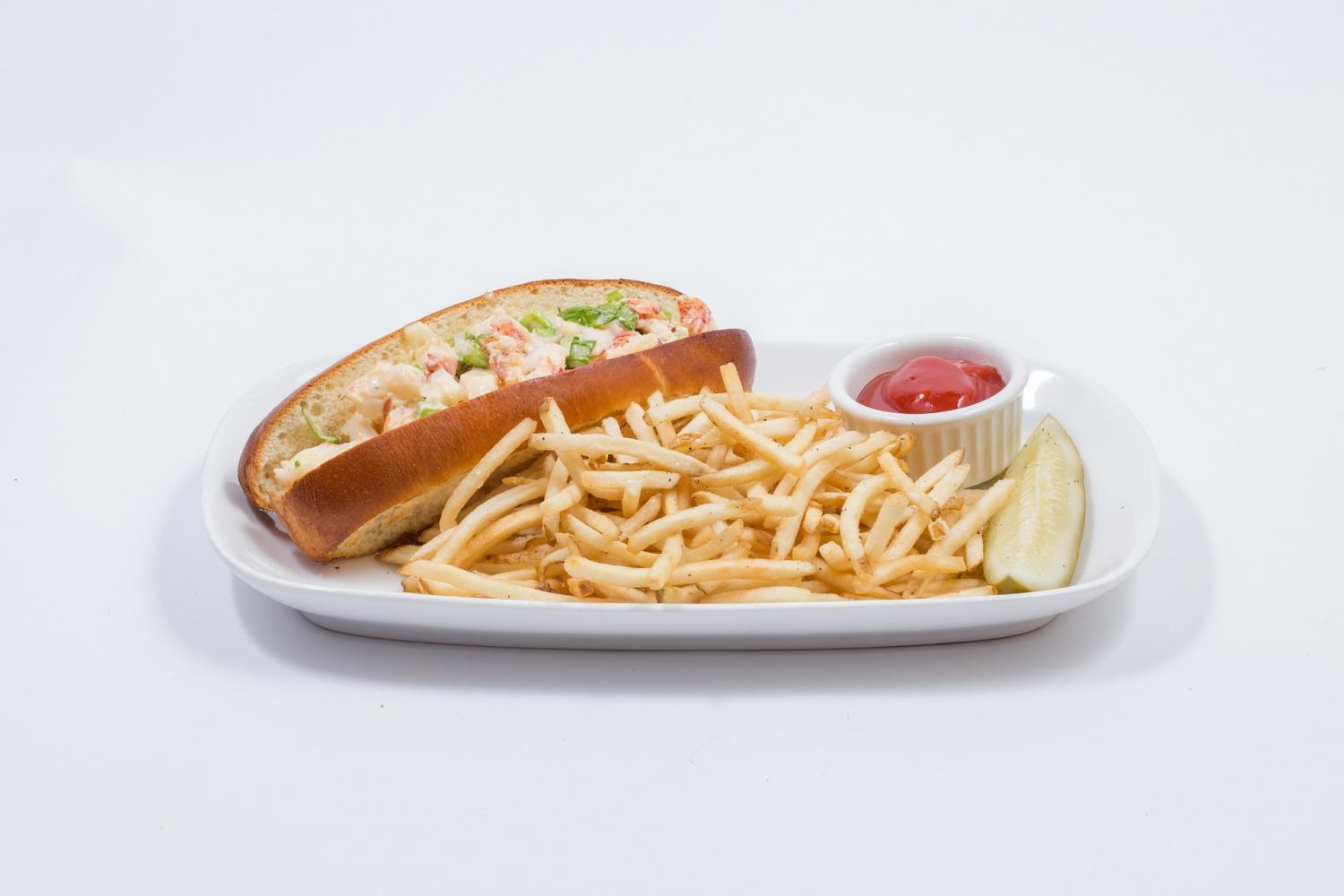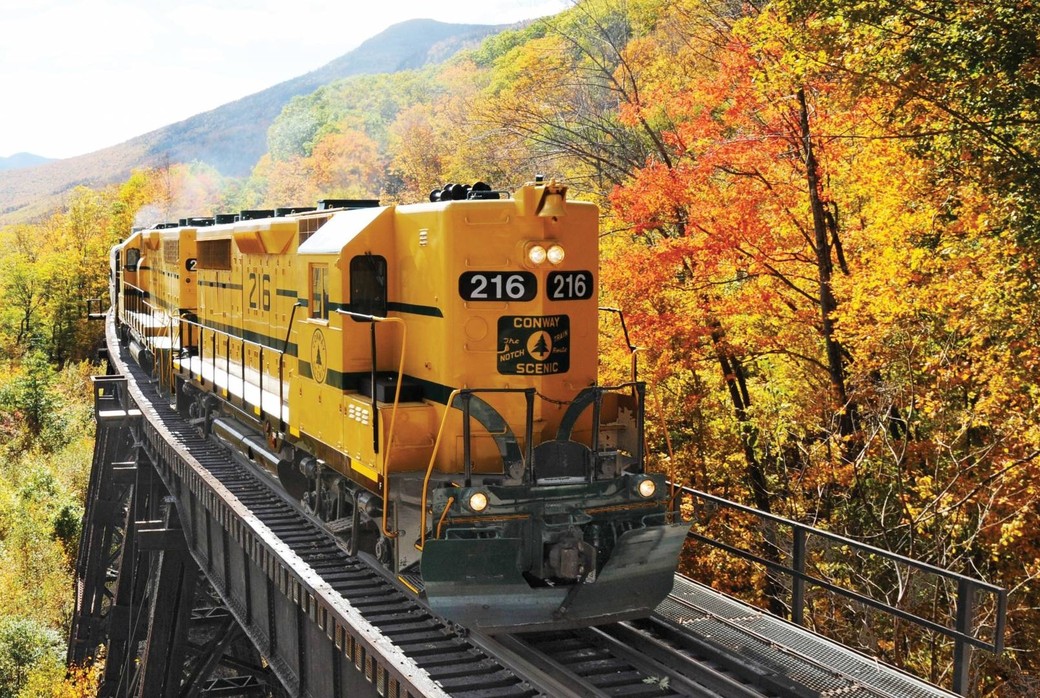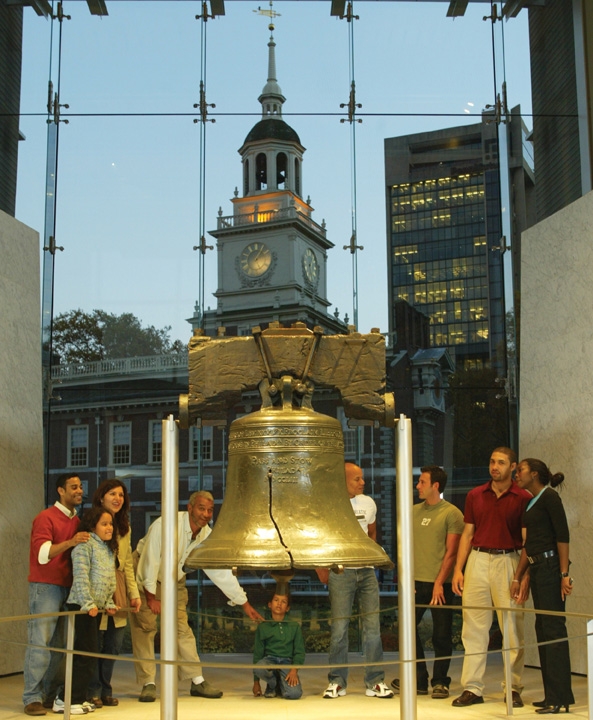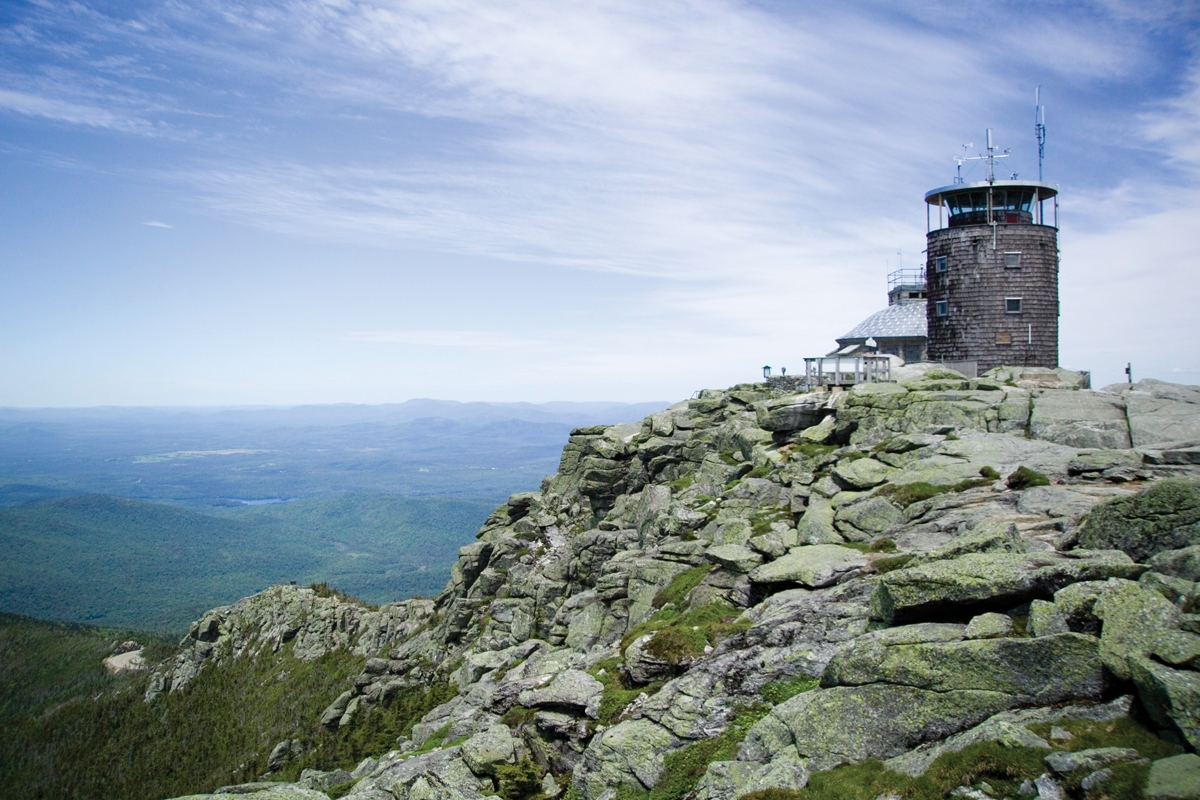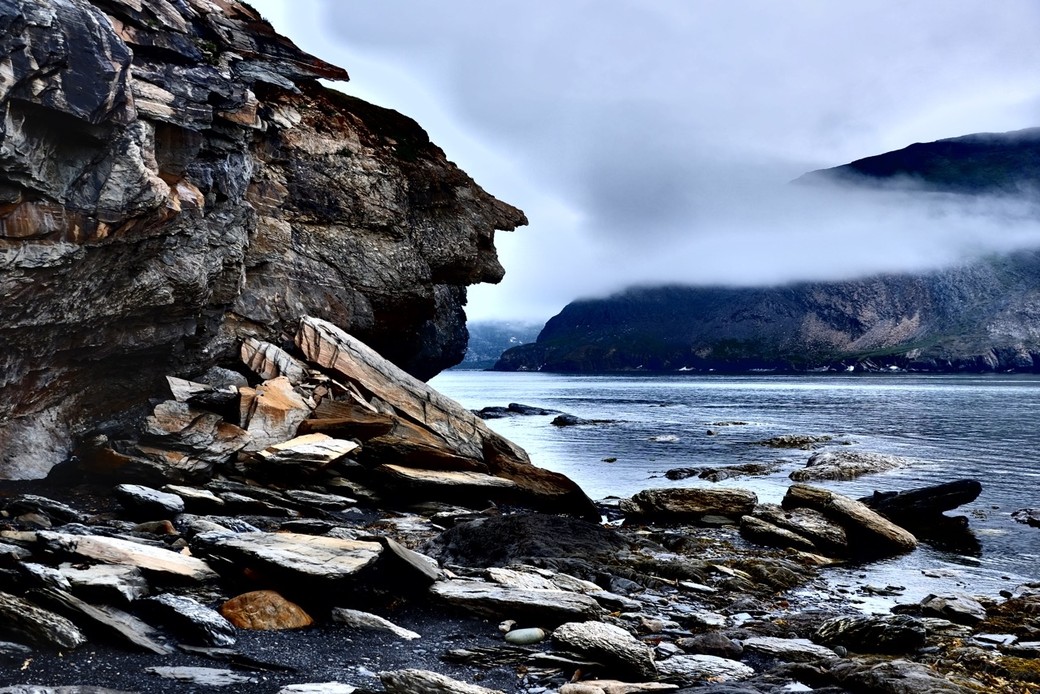
Adventure, Canadian Style Part One
All photos courtesy of Don MacLean.
Echoes of Newfoundland’s Past
“Go out to the deck,” we were told over the ship’s PA system. “Whales have been spotted off the port side.” I hurried outside, eager to catch a glimpse. It was July but the morning sea air was cool, invigorating. The water was calm as the ship cruised slowly by rolling mountains silhouetted against the clear morning sky. We leaned against the ship deck’s railing, necks strained and cameras cocked, patiently waiting. In addition to patience, whale watching requires quick, alert eyes. They’re easy to miss and when they do emerge from the water it’s only for a few fleeting, tantalizing moments. On this morning, however, the wait wasn’t long. There were at least two whales traveling together – most likely minke, we were later told – whose rounded backs and dorsal fins broke the water somewhere between our ship and land. Although their underwater movements are unpredictable, I followed their line and saw them emerge again from the water some short distance later. There was to be no full breach but the thrill was no less intense.
The minke whales siting was exhilarating if not totally unexpected. I was aboard what was the Ocean Endeavour’s maiden voyage with Adventure Canada. The family run company specializes in adventure cruises to far flung places that would be hard to access on one’s own – most notably the Arctic region – and where whales, black bears, polar bears and other magnificent creatures are familiar and vital parts of staggeringly beautiful landscapes. On this especially fine day we were cruising on Bonne Bay, located off the Gulf of St. Lawrence and the west coast of Newfoundland.
The “Newfoundland and Wild Labrador” cruise – as it was billed – began on a sunny day in St. John’s Harbour and ended on another sunny day in the small community of Kangiqsualujjuaq in Northern Quebec. In between those two far flung points we visited communities, UNESCO designated world heritage sites, and other less known but similarly breathtaking places. Following a visit to Saint Pierre and Miquelon we moved North up Newfoundland’s west coast, stopping at Gros Morne National Park, Red Bay and Saddle Island, Rose Blanche and Lanse aux Meadows and St. Anthony. Visiting those places alone, dear reader, would have constituted a trip of a life time. On this cruise they were just the beginning. For after sailing through the Strait of Belle Isle – separating Newfoundland and Labrador – we headed North along Labrador’s rugged East Coast. There were many stops along the way: Nain, Hebron, Ramah Bay, Eclipse Bay until, at last, we reached the province’s northern tip and sailed south towards the aforementioned Kangiqsualujjuaq. Each destination was more remote and, though it didn’t seem possible, more beautiful than the one before.
Our first destination is not part of Newfoundland and Labrador or, indeed, Canada. We would need our passports to set foot on Saint Pierre and Miquelon. The island is situated on the southern coast of Newfoundland near the Burin Peninsula. It remains part of France and, as a fellow passenger suggested, it feels like an extension of France. Despite its proximity and obvious physical similarities to Newfoundland, it also strikes the visitor as very distinctive from the province. License plates are European styled. France’s flag is prominently displayed. Cafes serve sandwiches French baguettes. The entire community speaks French.
The one full day spent entirely on the ship since leaving St. John’s had left me feeling slightly restless. When I stepped onto the island’s shore on the morning or our arrival it was with an almost palpable sense of relief. And when I stepped off the bus on which we initially toured the island I was most struck by the smell of the ocean air and the sounds of the water and waves slashing against the wind worn rocks. It seemed like an extension of that initial sense of relief.
We arrived on a Sunday, which is notable. The island is dotted with brightly coloured homes, but there were few locals to be seen. Not only is everything closed on Sunday, it seemed as though most of the community had left the island. Streets were unusually quiet. Homes with backyards clearly visible seemed empty. In anticipation of our arrival only a few cafes and small stores remained open. The effect was curious: the nearly deserted streets, empty backyards and closed stores created the impression we had the island to ourselves.
Apart from the stunning vistas and the narrow streets lined with colourful homes, St. Pierre is fascinating because of its history. Since the Portugese laid claim to it in 1520 the island’s status has been contested. Jacques Cartier declared it a possession of France in 1536. For the next three centuries the island changed hands between Britain and France until, at last, it reverted back to a French colony as part of the Treaty of France in 1814. No longer a colony, Saint Pierre and Miquelon now bears the awkward sounding status of “overseas collectivity.”
Its connection to the mother country, however, has been fraught. France’s Vichy government was notoriously complicit with German occupying forces in 1941, much to the shame of many French citizens. The same sort of division of opinion existed in St. Pierre and Miquelon, at the time a colony of France. Most of the island’s citizens were dismayed with the island administrator’s support for Vichy. They were thus likely relieved when Charles de Gaulle covertly engineered a coup on Christmas Day, 1941.
 Gros Morne National Park and Woody Point
Gros Morne National Park and Woody Point
The day spent at Gros Morne National Park started as they always do on the ship. Stefan Kindberg, our expedition leader, seemed to relish the responsibility of waking up all passengers. “Good morning, good morning, good morning,” he declares in a voice laden with experience but brimming with optimism. It’s 6.30 and after an eventful day and another late night, the call to get up arrives too early. I’d like another hour of sleep at least, but no matter. There’s another full day ahead. One doesn’t do this trip with Adventure Canada if the aim is to ease into every day. Adventure sometimes requires sacrifices, one of which can be sleep.
Shortly after breakfast we disembark onto the Zodiacs and boat the short distance to shore. We landed at Woody Point, a small shoreline community of approximately 1300 people. We’re not there for long before buses take us to an entry point to Gros Morne National Park, a UNESCO designated world heritage site. Our destination inside the park is the Tablelands. When we step off the buses my first impression is of being overwhelmed; I’m staggered by its rugged and distinctive beauty and scale. It’s like no other landscape I’ve encountered before. The mountains are a muted red and, from where we stand in the valley, appear to stretch endlessly into the distance. This initial impression fuelled another, one that was to be repeated throughout the journey: that in stepping foot on the Tablelands we were, in a sense, stepping into the past. Or, to put it another way, the past – both ancient and more recent – was everywhere manifest in ways not really possible in the constantly changing urban environments from whence so many of us came.
Not long after disembarking we begin a moderately vigorous trek with a Parks Canada guide upwards through the valley. It ends at what looks to be an endlessly meandering stream through opposing mountainsides. When talking with a knowledgeable Parks Canada Guide or a geologist working with Adventure Canada a walk among the Tablelands is more than an opportunity to witness first hand nature’s magnificence. It also amounts to a fascinating lesson in geology and evolution. The Tablelands formed as a consequence of a continental collision approximately 450 million years ago. The rock was part of the mantle beneath the Iapetus Ocean. Geologically unusual, the giant mass thus shifted from its place beneath the ocean to its present position. As our very funny Parks Canada guide explained, peridotite is the rock most fundamental to the Tablelands. The rock, when altered by the release of its calcium, forms what is called serpentinite. Peridotite is also iron filled; the iron reacts to the presence of oxygen, one effect of which is to give the Tablelands its ochre colour. Both are combination of red, brown and yellow and both have the stark look of a desert. More than one person remarked on its resemblance to the surface of Mars.
Looks, however, can be deceiving. Although the Tablelands does indeed look harsh and somewhat barren, water still flows among its hills and some vegetation has learned to thrive. One has to only look up at the mountain tops to see isolated pockets of hardened snow. These sorts of details assume great significance when walking among the Tablelands. Vegetation is scarce but what little there is tells a remarkable story. The soil is nutrient poor. That which plants needs – calcium, nitrogen, phosphorous and potassium – are in short supply. Those elements that plants can do without – severely alkaline groundwater, insecure slopes and running soil – are common and thus plant growth that much more challenging.
Not surprisingly, that which has managed to thrive are not only the hardiest of plants. Their adaptability is an example of the ingenuity at the heart of the natural world. To compensate for the nutrient poor soil, for example, Newfoundland’s official plant – The Pitcher plant – derives much of its nutrients from insects. As Michael Burzynski explains in his book Gros Morne National Park, unsuspecting critters are trapped in the “red-veined hollow leaves.” The insects eventually drown in the collected rainwater, following which they undergo a process of breakdown enabled by other insects, rotifers and bacteria. The plant thus doesn’t so much consume the insect as it absorbs its “molecular remains.” It’s among the myriad of examples of the evolutionary dynamic in play. In addition to the park’s grandeur, it is these sort of subtle relationships among soil, plants and other forms of life that inspire a sense of wonder.
It didn’t end there. “Look at the relatively barren, rock strewn mountain,” our guide begins to instruct us, “and the tree filled mountain on the other side of the highway. Which do you think is higher?” The answer is not immediately obvious. To the unwitting eye, the two look approximately the same height. “The mountain over there,” someone answered, pointing to the tree filled mountain. That, as it turned out, was incorrect. The guide explains that the trees provide a point of reference that the barren hillside lacks. As a result, the untrained eye is unable to judge its height. “This hill,” our guide says pointing to the barren mountain, “is approximately 150 metres higher than the tree filled mountain across the way.” 150 metres higher!
After lunch and another vigorous walk through a trail in Woody Point we returned to the ship. I was fatigued in the pleasurable sort of way that comes from a day of steady movement under a warm sun. It was a day well spent. Dinner was only a few hours away, where another kind of adventure would be resumed. In addition to fine food every day and for every meal, the dining room – as they so often do – became a place where lively discussions were had, stories and jokes exchanged and friendships formed. Indeed, talking to people you did not know before setting foot on the ship became a vital part of the adventure. You never really knew in advance where conversations would go or what you might discover. I recall a long conversation with a German anesthesiologist who loved to hike and who was living his dream of traveling the entire east coast of Canada. Over lunch we debated the merits and demerits of the European Union. On another day I spoke with a young Cuban filmmaker now living in Newfoundland. She loves her new home but dearly misses her family living in Cuba.
Red Bay Saddle Island
When we set out this morning for Red Bay the sky was overcast, but the view was clear and the rain had not yet started to fall. After returning to the ship for lunch we rested briefly before preparing to set out for Saddle Island. By the time we reached the Zodiac that would take 10 of us to the island, the skies had darkened and a steady rain was falling. This felt appropriate somehow. I was so relieved that the first few days were dry and occasionally sunny that I felt I needed to experience a rain filled expedition. Otherwise how adventurous could I really claim to be? By the time we reached our destination – the Zodiac ride from the ship to shore was only 5 -10 minutes – the rain’s intensity had increased. More appropriate still, a fog was slowly gathering over the water and shrouding the hillsides that shaped the Bay. The combination of rain and fog conspired to give the island and the surrounding area a ghostly feel.
If Gros Morne was about ancient geological history, Red Bay and Saddle Island are about more recent human history. Within minutes of having arrived at Saddle Island we set out on a tour led by yet another thoughtful and knowledgeable Parks Canada guide. There are no residences on Saddle Island. Although homes dot the landscape across the Bay, one is struck by the sense that the small community remains visibly and inextricably tied to the past. Both Red Bay and Saddle Island were critical in the complicated relationship among the Inuit, early European explorers and the natural world upon which they both relied. Spanish and French Basque arrived in the 16th century in search of mostly bowhead and right whales. The magnificent creatures of the sea were a vital source of the oil used to power both industries and homes back in Europe. The oil was, moreover, a vital source of profit. “This area was home to the first oil boom,” our guide said, a remark at once funny and illuminating. Whale populations were high and there was evidently little sense among the European whalers of natural limits. Countless whales were thus killed.
Both Red Bay and Saddle Island are living monuments to this critical period in the history of contact between Europeans and the Inuit. This is no doubt why the island was designated as a UNESCO World Heritage site. Its designation is meant as an act of preservation: not only of the island’s ecological integrity but its connection to the past. Archeological discoveries have paved the way to a more nuanced understanding of the time. In 1565 a whaler ship – San Juan – sunk in the Bay after powerful north east winds broke anchorage. The doomed ship was recently excavated and then carefully returned to the sea. In 1965 another ship broke down in the Bay and was eventually evacuated. Its slowly disintegrating hull rests in the bay, a haunting relic of a not too distant era. The walk yields more insights into life on the island 4 centuries ago. We are shown sites of ‘trywalks,’ the Basque rendering stations used to process the whales killed at sea.
 Lanse aux Meadows and St. Anthony
Lanse aux Meadows and St. Anthony
Later that day we resumed our journey north towards Lanse aux Meadows, located on the northern tip of Newfoundland, not far rom where the Gulf of St. Lawrence meets the Labrador Sea. By this point in our adventure I’m beginning to appreciate just how privileged an experience this is. This is the third UNESCO designated world heritage site in an as many days. The designation, we will soon discover, is well deserved.
After an informative introduction to the site in a beautiful welcome centre, we walk across the grassy, relatively flat terrain towards where the land meets the sea. This is among the places of earliest contact between the Norse and North America Aboriginals, sometime in the 11th century. Remarkably it was only in 1961 that a married Norwegian couple, with the help of a local fisherman, discovered and excavated (in cooperation with Parks Canada) eight Norse sod houses. Among the day’s highlights was stepping into the houses and witnessing recreations of life at the time. In a similar way Lanse aux Meadows draws visitors into the past.
Before visiting the home of St. Anthony’s most famous physician, Dr. Wilfred Grenfell, there was a 2 or 3 hour window of free time. We could return to the ship or stay on shore. By chance really I found myself walking with two other passengers. I relished the opportunity to explore and I would venture to guess they felt the same way. As inspiring as well planned expeditions can be, the unplanned stretches of time can produce equally memorable moments. The manager of a store in St. Anthony in which we were perusing was kind enough to give the three of us a ride to the aptly named “The Lighthouse,” a small gem of a restaurant situated a top of a hill that doubled as a look out point over the water. The terrain is rugged and on this afternoon the wind was gathering strength and heavy clouds lay low in the sky. Rain seemed imminent. Before going in to eat we walked at the edge of the hill, marvelling at the views of the Bay.
The food at The Lighthouse was what one might expect for a restaurant located next to the sea. It was traditional seafare – fish and chips, hearty clam chowder soups, and pork beans – all expertly prepared. Over a deliciously hearty lunch and, more importantly, beer we laughed and talked. I was in accomplished company. Billy Gauthier is an Inuk stone sculptor whose star has rapidly risen in the world of stone art. Gary Clement is the cartoonist for The National Post and accomplished children’s books writer. We had all only met days earlier and yet we talked as old friends might, exchanging friendly jokes at each other’s expense and sharing stories about our first days aboard the Ocean Endeavour. Billy spoke of his life in Goose Bay: his love of the land and of seal hunting. Little did I know at the time that this theme – traditional Inuit ways of life – was to become central to our experience travelling through Labrador.
It was also one of those entirely unpredictable experiences that was among the most memorable in Rose Blanche, where we had visited days earlier. After disembarking from buses that took us from the shore to somewhere inside the community, we began a long walk that ended where the stone lighthouse for which Rose Blanche is renowned sits atop a rocky summit. It was another glorious day for looking out at the sea.
Yet as strikingly beautiful as the view from the lighthouse summit was, what I will remember most from this day took place in a local church basement. The walk back from the lighthouse was to end with a welcome celebration hosted by community locals. The experience was my first of Newfoundland and Labrador hospitality, for which the province is justifiably famous. Locals had made an impressive spread of homemade sweets and drinks. They welcomed us as though we were long lost family who had finally made our way home. A local band played on a stage at the back of the room. It was the sort of fiddling music one could dance to if one was so inclined. Alas the dance floor remained empty. I stood at the front of the room eating some sweets and talking to a new acquaintance. A fellow passenger then meandered over to ask my friend to dance. He explained why he was not up to it at the present time: the dance floor was empty and he was shy. So she turned to me with a look that indicated I had no choice but to join her. She was not about to be rebuffed twice and I wasn’t about to create a potentially awkward situation. So I followed her to the floor. If she had any qualms about we being the only two dancing, she didn’t show it. She moved freely, without inhibitions. Lamely no doubt, I tried to follow her lead and simply let go.
“Move your feet,” I pleaded with myself.
After a few moments the Canadian author Kathleen Winter bounded to the stage to join us. She gracefully leapt and moved her arms as though in a joyful trance. Not long after another passenger ran to the floor. Like my other two dance partners, she moved freely, beautifully. The crowd was clapping to the music, urging us on. So the four of us danced about, locking arms and letting go and then doing it all again and again.
Joyous moments, I was discovering, can happen when one least expects it. There were many more still to come.
Adventure, Canadian Style Part 2 can be read Here.



